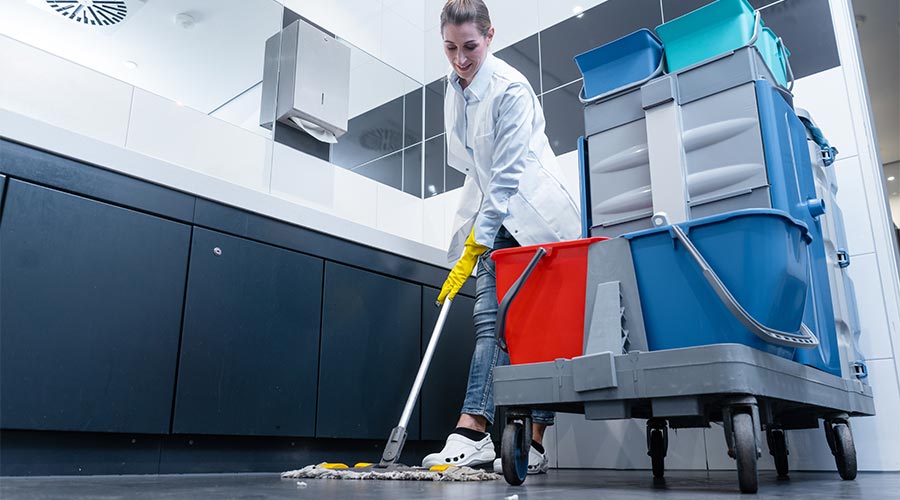
Nobody loves cleaning restrooms. The job is germy, smelly, and unpleasant. It’s also physically uncomfortable. To do it right, workers must contort their bodies into unnatural positions — twisting, bending, squatting, and crawling to reach around fixtures and into tiny gaps.
Doing this over and over leads to injury, unhappy workers, and higher turnover. Luckily, there are ergonomic tools jan/san distributors can recommend, making the job faster and easier, while helping a client’s bottom line.
A Dirty, Painful Job
Rare is the custodian who highly rates the task of restroom cleaning.
“For a professional cleaner, restroom cleaning is hard and challenging,” says John Herrera, chief revenue officer, Maintex, City of Industry, California. “You never know what you’re going to walk into.”
Plus, there are a lot of factors out of the cleaner’s control. There could be issues with the flooring or the plumbing that complicate the process. Even the building’s vintage plays a role since older building materials might not look very clean after servicing.
“Thirty-year-old grout is going to look aged and stained no matter how hard you try to clean it,” Herrera adds.
Then there’s the physical actions required to service restrooms. According to Neal S. Duffy
CCE, AAP, CMI master trainer, ISSA CIMS assessor, GBAC advisor, the job is no picnic.
“Routine cleaning and disinfection of the many surfaces and fixtures in restrooms involves a range of repetitive movements that often require bending, stooping, excessive reaching and applying pressure to adequately contact and clean these areas,” he says. “The repetitive nature of these actions, along with applying pressure to the cleaning cloth or tool, can be somewhat awkward and challenging for custodial workers.”
Even what seems like an easy task can be difficult and unwieldly.
“Refilling soap dispensing systems in restrooms often requires a worker to get on their hands and knees to unscrew panels. Meanwhile, servicing air care systems demands they get on a step ladder, increasing the risk of a fall,” says Herrera.
Falls may be an obvious, immediate risk, but the real dangers of restroom cleaning tend to be cumulative and more insidious.
“The classic cleaning methods of scrubbing floors, toilets, and sinks manually can be physically demanding and can cause Repetitive Stress Illness (RSI), leading to ongoing pain and arthritis over time,” says Kevin Chow, president/CEO, Triple S., Nashua, New Hampshire. “Bending and stooping can affect the workers’ backs and knees. Plus, there’s the chemical exposure that can be harsh and irritating to the skin, eyes, and respiratory system. Heavy lifting of water buckets and cleaning equipment can also put strain on the muscles, especially if cleaners are using poor body mechanics.”
This, according to Chow, not only affects the health of the workers, but the companies who employ them, especially after someone gets hurt. A single worker’s compensation claim can cost businesses anywhere from $20,000 to over $100,000.
Essential Ergonomics
Thankfully, there are tools and techniques designed to eliminate some of the risks of restroom cleaning. Allen Rathey, president, Winning Environments, LLC and
USGBC Green Classroom Professional (GCP), puts the innovations into historical context.
“In the 20th century, ditch digging was transformed from back-breaking work to relative ease when the small manual shovel was replaced with powered backhoes and bulldozers,” says Rathey. “This parallels improvements in restroom cleaning technology from spraying, wiping, and mopping to extraction methods such as spray-and-vac and dispense-and-vac tools that clean better while reducing, if not eliminating, ergonomic stress.”
These machines also bring some much-needed dignity to a rather distasteful job. Not only are motorized tool options very efficient, but they also keep the worker in an upright posture, eliminating the bending, lifting, and twisting required by traditional tools. Some manufacturers advertise no-touch cleaning, meaning they put distance between the workers and the unpleasant germs and pathogens found in every restroom.
Power scrubbers, no-touch cleaning systems, and robot vacuums represent the state-of-the-art ergonomic restroom products distributors should be promoting. There are other improvements to classic tools that can also make a difference at a smaller price tag.
“There’s lighter weight janitorial carts, ergonomic mop handles, and backpack vacuums, too,” says Chow.
Duffy agrees and highlights tools that not only make cleaning more ergonomic, but more effective.
“Scrubbing tools on long handles that allow the custodial worker to remain upright and still reach confined areas of the restroom are a great start,” he says. “These tools are typically adjustable in length and in type or style of brush or pad.”
Rathey builds onto that list.
“Microfiber mops and cloths are lightweight and efficient, minimizing the force and effort needed during cleaning,” he says. “Ergonomic scrubbers are designed to fit comfortably in the hand, reducing hand and wrist strain. While no-bend dustpans, equipped with long handles eliminate the need to bend over to collect debris.”
When promoting these products to end users, distributors must remember that there are benefits beyond ergonomics.
“Ergonomic cleaning and disinfection methods not only help reduce injury and fatigue for our custodians, but they also dramatically reduce cleaning time while increasing the overall effectiveness of the program,” says Duffy. “The right tools and process reduces the time needed to clean and disinfect surfaces. They will also improve sanitation, reduce residual odors, and cut down on restroom complaints.”
Along with increased and improved productivity, ergonomic restroom cleaning tools can reduce overall costs by attracting and retaining talent, says Chow. This is vital to an industry suffering from high annual turnover rates. The constant churn of recruiting, onboarding, and training drives up labor costs while cutting into overall work quality.
Promoting Ergonomic Restroom Tools in Facilities

 The Down and Dirty on Cleaning in Virus Season
The Down and Dirty on Cleaning in Virus Season How Surfactant Use is Expanding in Commercial Cleaning
How Surfactant Use is Expanding in Commercial Cleaning